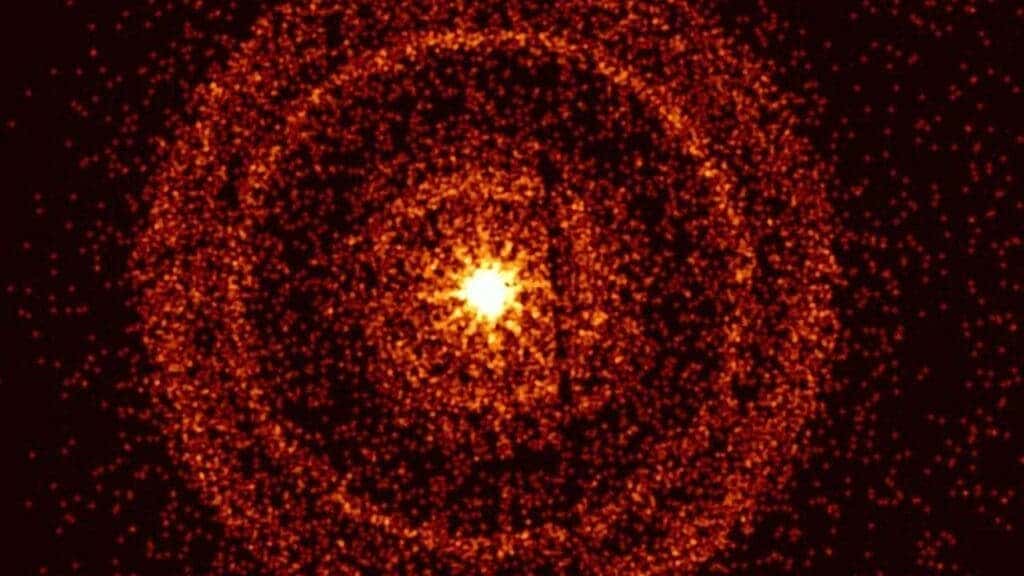Gamma-ray bursts are the most powerful and brightest explosions in the universe. Now astronomers have found the one to top them all — at leasat for now.

Telescopes first detected Gamma-Ray Burst (GRB) GRB221009A on October 9 by the Chinese Large High Altitude Air Shower Observatory; it is the most powerful electromagnetic explosion ever observed. Lasting anywhere from a few milliseconds to several minutes, GRBs shine hundreds of times brighter than a typical supernova and about a million trillion times as bright as the Sun.
When a GRB erupts, it is briefly the brightest source of cosmic gamma-ray photons in the observable Universe.
“The exceptionally long GRB 221009A is the brightest GRB ever recorded and its afterglow is smashing all records at all wavelengths,” said University of Maryland/George Washington University graduate student Brendan O’Connor who worked on the study. “Because this burst is so bright and also nearby, we think this is a once-in-a-century opportunity to address some of the most fundamental questions regarding these explosions, from the formation of black holes to tests of dark matter models.”
In the 1960s, gamma-ray bursts were accidentally discovered by U.S. military satellites. They are thought to be caused by the explosions of dying stars or by the collisions of neutron stars, which are ultradense stellar remnants. These explosions release more power in a matter of seconds than the sun will produce in its entire 10 billion-year lifespan.
The flash detected released 18 teraelectronvolts (one teraelectronvolt is 1,000,000,000,000 electron Volts) of energy. If the measurements hold up, this would be the first gamma-ray burst ever discovered to have an energy greater than 10 teraelectronvolts (TeV), though the scientists are still analyzing the data.
Initially, astronomers were baffled by the intensity of the flash and assumed it had come from a nearby object. They also at first thought that X-rays, rather than gamma rays, were the source of the energy. The signal was later analyzed, and its authenticity as a gamma-ray burst from 2.4 billion light-years away was verified. Although the gamma-ray burst was not exactly nearby, it was the closest one ever observed.
This burst was relatively far from Earth, but any closer would have been disastrous. Even thousands of light-years away, such a powerful burst would strip Earth of its protective ozone layer and likely cause mass extinction. According to NASA, theorists believe that a similar explosion may have caused the Ordovician extinction 450 million years ago, one of the largest extinction events in Earth’s history.
Although the burst was seen to be 20 times closer to Earth than the typical gamma-ray burst, it is still far enough away to cause more excitement than concern.
“In our research group, we’ve been referring to this burst as the ‘BOAT’, or Brightest Of All Time, because when you look at the thousands of bursts gamma-ray telescopes have been detecting since the 1990s, this one stands apart,” said Northwestern University grad student Jillian Rastinejad, who also worked on the project. “Gemini’s sensitivity and diverse instrument suite will help us to observe GRB221009A’s optical counterparts to much later times than most ground-based telescopes can observe. This will help us understand what made this gamma-ray burst so uniquely bright and energetic.”
Another gamma-ray burst of this intensity might not be seen for centuries. Other extraordinary reports of disturbances in the Earth’s ionosphere affecting long-wave radio transmissions due to the energetic radiation from the GRB221009A event have also been received. Right now, it’s a bit puzzling to scientists how 18 TeV photons could defy our current understanding of physics and make it to Earth in 2.4 billion years.









